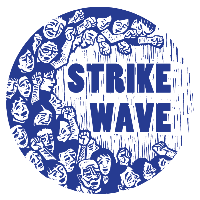Want a union? Here are some things to know.
by C.M. Lewis
A lot of folks wish they had a union and don’t know where to start.
By a lot, I mean a lot. The latest Bureau of Labor Statistics numbers put union density (the percentage of the workforce that’s unionized) at 10.5%. For context, that’s closer to density in the 1920s than it is density in the 1950s, and about 10% less than in 1983. It’s even lower in the private sector, clocking in at around 6.4%. In other words, the vast majority of Americans don’t have a union, and may not have an immediate relative that had or has a union, either.
That means that the vast majority of Americans also don’t have what’s known as “just cause” protections—the straightforward idea that if an employer fires you, they’d better have a good reason. Most Americans don’t have contractually guaranteed healthcare, predictable wage increases, nondiscrimination protections, guaranteed leave, and a host of other things that union contracts can guarantee. In other words, they don’t have a voice on the job: everything is determined by whether the boss wants it, or not. As a result, non-union workers are more vulnerable to exploitation; for example, wage theft takes billions out of the pockets of workers every year.
So why don’t more people seek out a union?
There are a lot of reasons cited. Lack of time, lack of organizing experience, apathetic coworkers, fear of retaliation; often, folks believe that unions won’t work in their industry. Going to talk to coworkers about fixing problems at work is intimidating: most people want to clock in, keep their head down and do their jobs, and clock out. But the single most common reason I hear is straightforward: unions and unionization are buried in a labyrinth of regulations and procedures, and it’s confusing to even know where to start.
Before the National Labor Relations Act (1935) and the growth of labor law protecting union activity and workers’ rights, unions were fairly simple: organized workers can fight for their own interests. And it’s actually still that simple in many respects, regulations and procedures notwithstanding. If you’ve ever worked with other employees to fix a problem on the job, you’ve started the foundations of a union.
That’s called “protected concerted activity”—a legally intimidating term that simply means you have the right, whether you’re officially part of a union or not, to work with your coworkers to advocate for better pay, benefits, and working conditions. Even aside from practical protection in numbers, there’s legal protection in numbers: if you address a workplace issue with two or more coworkers, you’re probably protected under the law.
Is legal protection bulletproof? No. Employers didn’t care about the law a hundred years ago, they didn’t care about it fifty years ago, and they don’t care about it today. Workers do face illegal retaliation, whether it’s shift changes, demotion, reprimand, or firing. National Labor Relations Board (NLRB) penalties for retaliation are minimal; employers figure that having (at most) to pay back wages is a small price to pay for stopping a union drive. These days, the NLRB isn’t too friendly to worker rights, either.
There’s some risk, and there’s no way to sugarcoat that. But there’s strength in numbers, too. One person standing alone is easy to target (or say no to); a group is a lot harder to handle. If one person goes to the boss with a problem, it’s easy to tell them no or intimidate them into silence. If an entire shift goes to the boss with a problem, then they’ve got a mess on their hands. This is fundamentally the premise of union organizing: when we work together, we get results.
Not everyone is going to go out and organize a union at their workplace. But it’s more possible than people think, and it delivers something that nothing else can: a voice on the job. In a society where there are increasingly few places where we can genuinely be heard, bringing democracy into the workplace is worth its weight in gold.
If you can, start talking to folks. Start sharing problems. Start figuring out, “What can we do about this?” Start thinking about how you’d like your job to be, rather than just accepting how it is. Chances are you know what it takes to improve your workplace better than your boss does.
And make sure to work together. It gets results.
C.M. Lewis is a union staffer in Central Pennsylvania and a member of the Strikewave editorial collective. The views expressed are his own.
Want advice on organizing, job issues, or pointers on where to start? Give us a holler at news@thestrikewave.com.
Further resources:
Labor Notes - Secrets of a Successful Organizer
WorkplaceFairness - Know Your Rights

